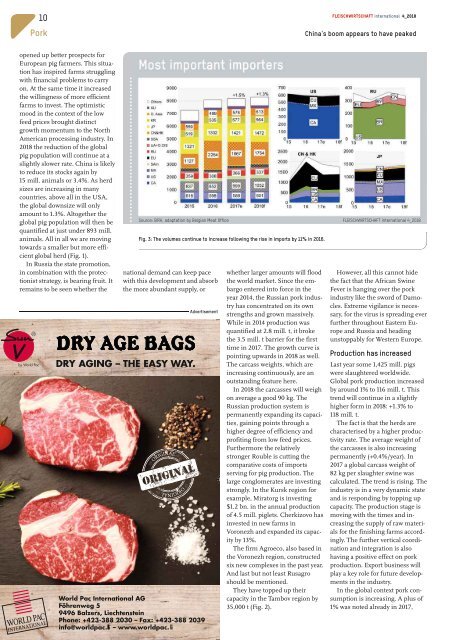FLEISCHWIRTSCHAFT international_04_2018
- No tags were found...
You also want an ePaper? Increase the reach of your titles
YUMPU automatically turns print PDFs into web optimized ePapers that Google loves.
.....................................................................................................................................................................<br />
10<br />
Fleischwirtschaft <strong>international</strong> 4_<strong>2018</strong><br />
Pork<br />
China's boom appears to have peaked<br />
opened up better prospects for<br />
European pig farmers. This situation<br />
has inspired farms struggling<br />
with financial problems to carry<br />
on. At the same time it increased<br />
the willingness of more efficient<br />
farms to invest. The optimistic<br />
mood in the context of the low<br />
feed prices brought distinct<br />
growth momentum to the North<br />
American processing industry. In<br />
<strong>2018</strong> the reduction of the global<br />
pig population will continue at a<br />
slightly slower rate. China is likely<br />
to reduce its stocks again by<br />
15 mill. animals or 3.4%. As herd<br />
sizes are increasing in many<br />
countries, above all in the USA,<br />
the global downsize will only<br />
amount to 1.3%. Altogether the<br />
global pig population will then be<br />
quantified at just under 893 mill.<br />
animals. All in all we are moving<br />
towards a smaller but more efficient<br />
global herd (Fig. 1).<br />
In Russia the state promotion,<br />
in combination with the protectionist<br />
strategy, is bearing fruit. It<br />
remains to be seen whether the<br />
Source: GIRA, adaptation by Belgian Meat Office <strong>FLEISCHWIRTSCHAFT</strong> <strong>international</strong> 4_<strong>2018</strong><br />
Fig. 3: The volumes continue to increase following the rise in imports by 11% in 2016.<br />
national demand can keep pace<br />
with this development and absorb<br />
the more abundant supply, or<br />
Advertisement<br />
whether larger amounts will flood<br />
the world market. Since the embargo<br />
entered into force in the<br />
year 2014, the Russian pork industry<br />
has concentrated on its own<br />
strengths and grown massively.<br />
While in 2014 production was<br />
quantified at 2.8 mill. t, it broke<br />
the 3.5 mill. t barrier for the first<br />
time in 2017. The growth curve is<br />
pointing upwards in <strong>2018</strong> as well.<br />
The carcass weights, which are<br />
increasing continuously, are an<br />
outstanding feature here.<br />
In <strong>2018</strong> the carcasses will weigh<br />
on average a good 90 kg. The<br />
Russian production system is<br />
permanently expanding its capacities,<br />
gaining points through a<br />
higher degree of efficiency and<br />
profiting from low feed prices.<br />
Furthermore the relatively<br />
stronger Rouble is cutting the<br />
comparative costs of imports<br />
serving for pig production. The<br />
large conglomerates are investing<br />
strongly. In the Kursk region for<br />
example, Miratorg is investing<br />
$1.2 bn. in the annual production<br />
of 4.5 mill. piglets. Cherkizovo has<br />
invested in new farms in<br />
Voronezh and expanded its capacity<br />
by 13%.<br />
The firm Agroeco, also based in<br />
the Voronezh region, constructed<br />
six new complexes in the past year.<br />
And last but not least Rusagro<br />
should be mentioned.<br />
They have topped up their<br />
capacity in the Tambov region by<br />
35,000 t (Fig. 2).<br />
However, all this cannot hide<br />
the fact that the African Swine<br />
Fever is hanging over the pork<br />
industry like the sword of Damocles.<br />
Extreme vigilance is necessary,<br />
for the virus is spreading ever<br />
further throughout Eastern Europe<br />
and Russia and heading<br />
unstoppably for Western Europe.<br />
Production has increased<br />
Last year some 1,425 mill. pigs<br />
were slaughtered worldwide.<br />
Global pork production increased<br />
by around 1% to 116mill. t. This<br />
trend will continue in a slightly<br />
higher form in <strong>2018</strong>: +1.3% to<br />
118mill. t.<br />
The fact is that the herds are<br />
characterised by a higher productivity<br />
rate. The average weight of<br />
the carcasses is also increasing<br />
permanently (+0.4%/year). In<br />
2017 a global carcass weight of<br />
82 kg per slaughter swine was<br />
calculated. The trend is rising. The<br />
industry is in a very dynamic state<br />
and is responding by topping up<br />
capacity. The production stage is<br />
moving with the times and increasing<br />
the supply of raw materials<br />
for the finishing farms accordingly.<br />
The further vertical coordination<br />
and integration is also<br />
having a positive effect on pork<br />
production. Export business will<br />
play a key role for future developments<br />
in the industry.<br />
In the global context pork consumption<br />
is increasing. A plus of<br />
1% was noted already in 2017,

















